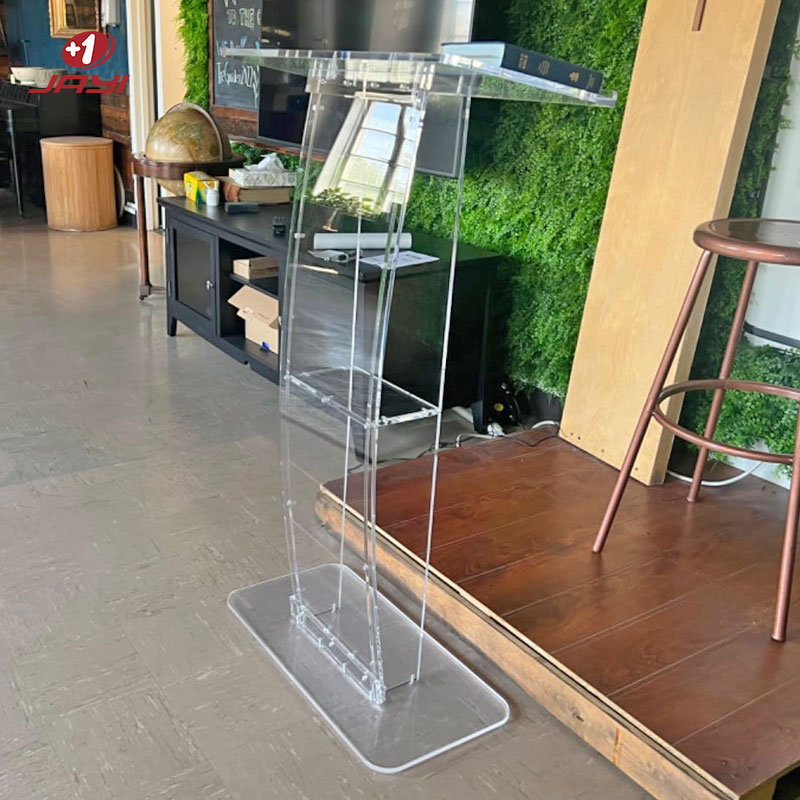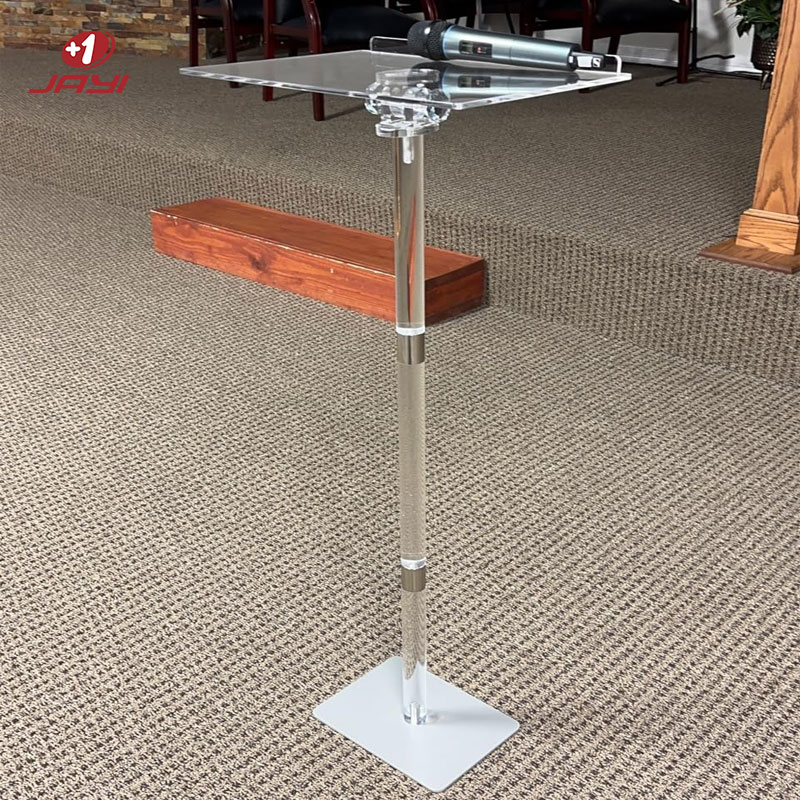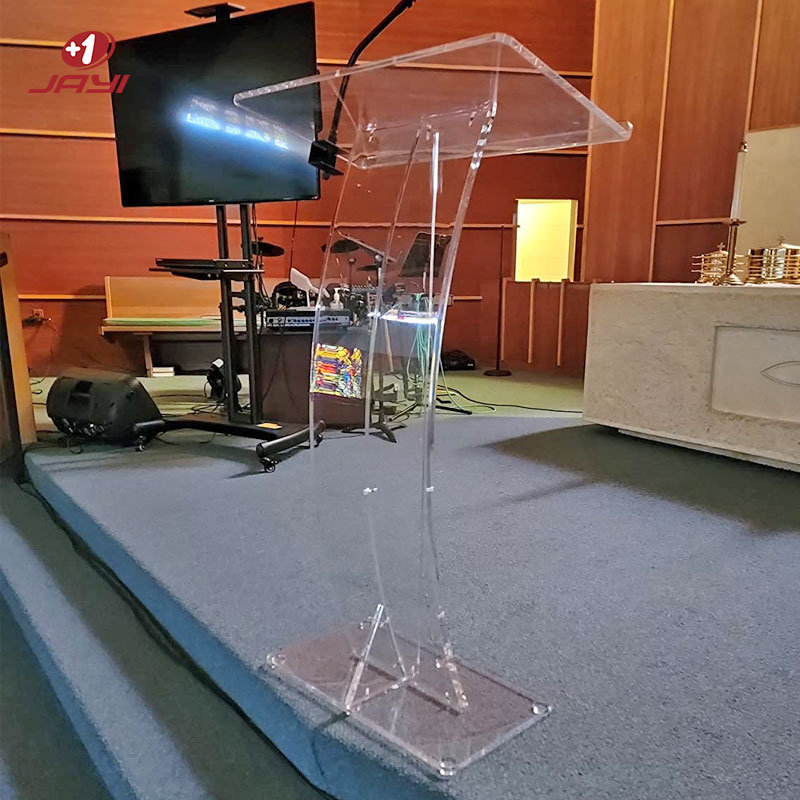As a common speech platform, the acrylic lectern podium must maintain a clean and dazzling appearance while providing a professional image. The correct cleaning method can not only extend the service life of the acrylic podium but also ensure that it always radiates unparalleled brilliance. This article will detail how to properly clean an acrylic podium to ensure it is clean, bright, and durable.
Step 1: Prepare the Tools to Clean the Acrylic Lectern
Before cleaning the acrylic podium, it is crucial to prepare the proper cleaning tools. Here are the tools you'll need:
Soft dust-free cloth
Choose a dust-free cloth with a soft texture, no fiber or fine particles to avoid scratching the acrylic surface.
Neutral cleaners
Choose neutral cleaners that do not contain acidic, alkaline, or abrasive particles. Such cleaners can effectively remove stains without causing damage to the acrylic.
Warm water
Moisten the cleaning cloth with warm water to help remove dust and debris.
Ensure that cleaning tools are of good quality and keep them clean and dedicated. With these cleaning tools in place, you're ready to clean the acrylic podium, making sure it stays clean, bright, and dazzling. Next, we will detail the cleaning steps.
Step 2: Gently Wet Wipe Acrylic Lectern
Before cleaning the acrylic podium, the first step is to conduct a gentle wet wipe. Here's how:
Wet the surface of the acrylic podium with water
Use water to gently wet the surface of the acrylic podium, which helps to remove dust and debris from the surface. You can use a watering can or a moist cleaning cloth to gently spray water to ensure that the entire surface is moist.
Choose a soft dust-free cloth for wiping
Choose one of the soft dust-free cloths you have prepared to make sure it is clean and free of any particles. Soak the cloth in warm water and wring it out so that it is slightly damp but not dripping.
Gently wipe the acrylic surface
With gentle gestures, gently wipe the acrylic surface with a moist clean cloth. Starting at the top, wipe the entire surface in a circular or straight line, making sure to cover all areas. Avoid overexerting or applying pressure to avoid scratching the acrylic.
Pay attention to corners and edges
Pay special attention to cleaning the corners and edges of the lucite podium. Using the corners or folded edges of the cloth, gently wipe these areas to ensure thorough cleaning.
By gently wetting, you can remove dust and debris from the surface, providing a clean base for subsequent cleaning. Remember to always use a soft, dust-free cloth and avoid fabrics with frayed or rough surfaces that can scratch the acrylic surface.
If you are in business, you may like

Plexiglass Pulpits for Churches

Acrylic Podium Lectern Pulpit Stand

Acrylic Pulpits for Churches
Step 3: Remove Stains from Acrylic Lectern
If you encounter stains while cleaning your lucite lectern, you can take the following steps to remove them:
Use a neutral cleaner
Choose a neutral cleaner and make sure it does not contain acidic, alkaline, or abrasive particles. Pour the appropriate amount of detergent onto a soft dust-free cloth.
Gently wipe the stain
Place a moist cleaning cloth on the stain and wipe with gentle gestures. Use small, circular motions and gradually increase the wiping force to help remove stains.
Apply the cleaner evenly
If the stain is stubborn, you can apply the cleaner evenly to the entire area and gently massage. Then use a moist clean cloth to wipe until the stain is completely removed.
Wipe with clean water
Use a moist clean water cloth to wipe the acrylic surface to remove the residue of the cleaning agent. Make sure to rinse thoroughly so as not to leave any residue on the surface.
Dry with a clean dry cloth
Finally, gently dry the acrylic surface with a dry soft dust-free cloth to prevent water stains from remaining.
Note that for stubborn stains, avoid using rough brushes or abrasive tools that may scratch the acrylic surface. Always clean with a soft dust-free cloth and a mild cleaner.
Step 4: Avoid Scratching the Acrylic Lectern
To avoid scratching the acrylic surface, during cleaning and maintenance, please pay attention to the following points:
Use a soft dust-free cloth
Choose a soft, fiber-free, or fine particle dust-free cloth to wipe the acrylic surface. Avoid rough fabrics or brushes as they may leave scratches on the surface.
Avoid abrasive substances
Avoid abrasive abrasives, grinding powders, or rough cleaners, which can scratch the acrylic surface. Choose a neutral cleaner that does not contain abrasive particles to protect the appearance of acrylic.
Avoid chemicals
Avoid cleaners with acidic or alkaline ingredients, as they may damage the acrylic. Choose a neutral cleaner to ensure that the acrylic surface is not damaged.
Avoid rough objects
Avoid using sharp, rough, or hard-edged objects that touch the acrylic surface directly. Such an object may scratch or damage the surface. When moving items or performing other activities, handle them carefully to avoid direct contact with the acrylic surface.
Replace the cleaning cloth regularly
Replace the cleaning cloth regularly to avoid the dust and particles on the cloth scratching the acrylic surface. Using a clean cloth reduces the potential risk of scratching.
By following these precautions, you can protect acrylic surfaces from scratching and damage. Keep in mind that acrylic is a relatively soft material that needs to be treated gently to keep its appearance clean and perfect.
Quality inspection is a key step to ensure product reliability and customer satisfaction, and Jayi is always committed to providing superior quality acrylic lectern solutions.
Step 5: Regular Maintenance of Acrylic Lectern
Regular maintenance of acrylic surfaces is key to ensuring that they remain clean and shiny for a long time. Here are some suggestions for regular maintenance:
Gentle cleaning
Do a gentle cleaning once a week or every two weeks. Use a soft dust-free cloth and neutral cleaner to gently wipe the surface to remove dust and stains. Avoid harsh or abrasive cleaners.
Prevent scratches
Keep the acrylic surface away from sharp or rough objects to avoid scratching. Use cushions or protective pads to protect surfaces, such as cushions or bottoms when placing items.
Avoid chemicals
Avoid using acidic or alkaline chemicals on the acrylic surface to prevent damage. Clean with mild, neutral cleaners and avoid alcohol or solvents.
Prevent high temperature
Avoid placing hot objects directly on the acrylic surface to prevent deformation or damage. Use an insulating pad or bottom to protect the surface.
Regular inspection
Check the acrylic surface regularly to note any scratches, cracks, or damage. Timely treatment and repair to ensure the integrity of the surface.
By maintaining acrylic surfaces regularly, you can extend their life and keep them beautiful. Keep in mind that acrylic is a relatively fragile material that requires gentle treatment and proper maintenance to maintain its elegance and durability.
Summary
The correct cleaning method can ensure that the acrylic lectern podium always stays clean and dazzling.
By gently wiping with a soft clean cloth, neutral cleaner, and warm water, stains and dust can be removed while avoiding scratching the acrylic surface.
Regular maintenance can extend the service life of the acrylic podium and ensure that it always shows a professional and refined appearance.
Be sure to follow the cleaning guidelines above to ensure that your acrylic podium stays clean, bright, and dazzling at all times.
Post time: Feb-19-2024
